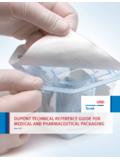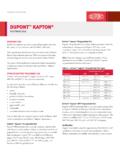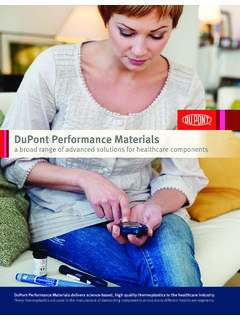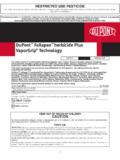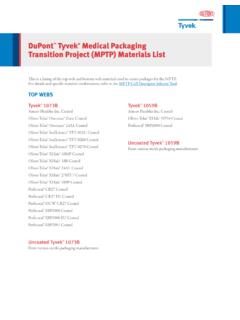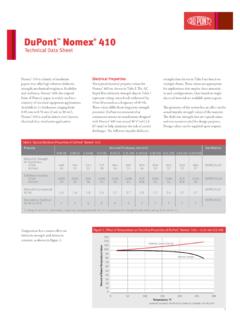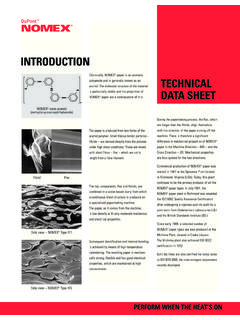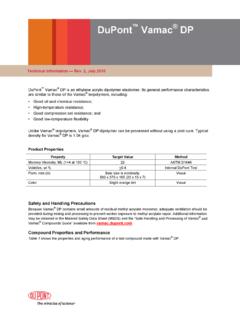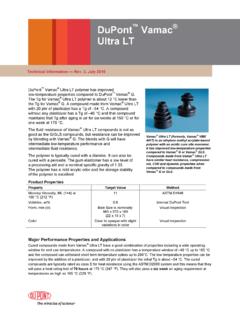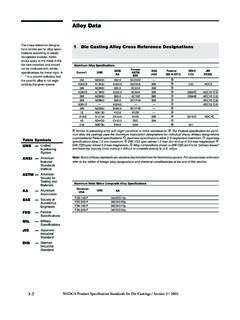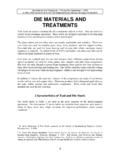Transcription of LDPE 6611 For Cast Film applications - DuPont
1 ++++++++++++++++++++++++++++++++++++++++ +++++++++++++++++++++++++++++ k Typical Purge Procedure with DuPontTM LDPE 6611 for cast film applications : Description: LDPE 6611 is a fractional melt index low density polyethylene resin that contains various additives to assist in purging and cleaning the extruder. This polymer is formulated with agents to help it wet and scour metal surfaces within the extrusion system. It also contains a blowing agent which helps to disrupt normal flow patterns and enhance scouring action. The resin normally will foam, snap, and crackle as it leaves the die. A somewhat fishy, ammonia smell is detectable from the extrudate and feed hopper. When extruded, the resin has a grayish brown color and a very high viscosity at the die exit.
2 applications : LDPE 6611 is not required for normal transitions into and out of Surlyn(R) ionomer resins, Nucrel(R) acid copolymer resins, and other common polyolefins. The Disco Purge Procedure* is recommended for use during these normal transitions, and special purging compounds such as LDPE 6611 are not part of this procedure. There are instances, however, when it is practical to use a special purging compound like LDPE 6611. Examples include: Cleaning particularly dirty extruders. Removing die lines caused by oxidized polymer deposits. Purging extruders that have chronic purging problems (gels) following runs of Surlyn(R) resins, Nucrel(R) resins, Elvax(R) ethylene vinyl acetate resins, or other specialty resins.
3 Consulting your technical representative is also highly recommended for these cases. Purging prior to extrusion jobs that are particularly sensitive to gels. Facilitating purging for shutdowns when normal Disco Purging has not proven effective. A shutdown is any period of time when the extruder will be completely turned off, such as a weekend or maintenance outage. It is very important that specialty copolymers such as Surlyn(R) and Nucrel(R) be completely purged before such a shutdown, as the cool-down, heat-up, and soak periods allow plenty of time to cause significant gel problems. Facilitating rapid removal of pigments from the extruder. LDPE 6611 has also been used to facilitate pulling and cleaning large diameter extrusion screws.
4 However, acrylic purge material is normally used for this purpose. The high viscosity of LDPE 6611 lends itself to easy cleaning of hardware during disassembly, because it peels rather than smearing along the metal surfaces. Although most frequently used on flat die extrusion equipment, LDPE 6611 can also be used for round die converting equipment as well. It can be difficult to purge LDPE 6611 out of standard spiral-fed blown film dies, unless a very low melt index polyethylene is available for this purpose ( MI LDPE or MI LLDPE). To activate the blowing agent, the resin must be extruded above about 221 C (430 F). Purging efficiency may be somewhat reduced if the resin does not foam.
5 Precautions: Adequate ventilation is required for use. Fumes from extrusion can be irritating to the eyes, nose, and throat. Fumes from high temperature extrusion of polyolefin resins contain various products of decomposition that may be toxic. Exploding bubbles can spit hot polymer as the melt exits the die. Proper protective apparel, including eye protection, should be worn. LDPE 6611 should not be extruded or exposed to temperatures above 315 C (600 F). LDPE 6611 does not comply with FDA regulations, so complete purging from the extrusion system is required. LDPE 6611 contains silicon dioxide to assist in scouring hard deposits from metal surfaces. Excessive use of this purge compound can cause premature equipment wear, particularly in some extrusion systems that are soft nickel plated.
6 For further information, please consult the Safety Data Sheet LDPE 6611 Purge Resin. ( cast film ) 1. Transition from any specialty resin to LDPE using the "Disco Purge/Resin Transition procedure". (A separate document on this procedure is available from DuPont .) 2. If there are deckles on the die, please remove the deckles and open back-pressure valve (if any) completely, as applicable. 3. Use several short (1 to 2 minute) cycles of high and low screw speed to remove most of the specialty polymer, or use the Disco Purge Procedure. (Watch that amps and pressure limits are not exceeded.) 4. Set temperature controls as follows: Use this profile for removing PE, EAA, EMAA, acrylate copolymers and terpolymers.
7 (See further below for EVA or Nylon resins): B1 B2 B3 B4 B5 Connect Die 410 455 500 500 500 500 500 F 210 235 260 260 260 260 260 C NOTE: These temperature settings may be too high for some resins being purged, such as: EVA based material. Do not exceed the resin suppliers' recommended temperature limits until the purging process is complete. Consult a DuPont representative before trying to purge an EVA based material directly with this compound. In coextrusion equipment, make certain that temperatures are not set so as to expose resins from other extruders to temperatures higher than their respective limits. EVA: For removing EVA and Nylon resins, the following temperature settings are suggested for each particular situation: B1 B2 B3 B4 B5 Connect Die 320 365 410 455 455 455 455 F 160 185 210 235 235 235 235 C When all EVA is cleared, then temperatures can be raised to a profile such as above for PE, acrylate copolymers, and EAA type resins as show in the above section.
8 Nylon: Use the following temperature profile for high melting point resins such as Nylon in any process: B1 B2 B3 B4 B5 Connect Die 500 500 545 545 545 545 545 F 260 260 285 285 285 285 285 C 5. Upon reaching the new temperature settings, drain the feed hopper and add LDPE 6611 as follows: Extruder Diameter (mm) 65 90 120 150 200 Minimum Number of Kilograms of LDPE 6611 that should be used for a typical cleaning. Adjust the amount of resin used according to experience of the operator and severity of the contamination problems. 10 15 25 50 75 6. Run the extruder at maximum allowable screw speed (watch amps and pressure). Cycling the screw speed a bit up and down will also be helpful during extrusion of the LDPE 6611 purge compound.
9 Once the extruder and die are full of the LDPE 6611, stop the screw for about 2 to 3 minutes to allow a "soak time". Then slowly start the RPM rolling again, and push the LDPE 6611 out of the extruder. When the hopper runs completely out of the LDPE 6611, move to step 7. Caution: do not attempt a full 'Disco Purge' method, as it is unlikely the extruder has enough kilowatts to push the LDPE 6611 at high RPM. Be careful to watch the amperage draw on the drive motor. 7. If casting film with a higher Melt Flow Rate, then follow LDPE 6611 with an intermediate melt index polyethylene (about 1 to 3 MI) until the LDPE 6611 is no longer seen in the extrudate. Then transition to a higher flow cast film LDPE with MI of about 2 to 6 dg/min.
10 8. Cycle screw speed or use Disco Purge Procedure as before, with the LDPE, once the LDPE 6611 seems to be mostly out of the extrusion system. 9. Follow with standard cast film grade LDPE or PP as appropriate. Repeat screw speed cycles or Disco Purge Procedure as needed. NOTE: The technical data contained herein are guides to the use of DuPont resins. The advice contained herein is based upon tests and information believed to be reliable, but users should not rely upon it absolutely for specific applications because performance properties will vary with processing conditions. It is given and accepted at user's risk and confirmation of its validity and suitability in particular cases should be obtained independently.
